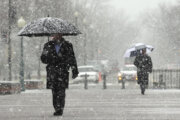Natural disasters have been on the rise in recent years, and young homeowners are taking notice.
According to a study from home insurance company Hippo, 96% of homeowners aged 18 to 29 have considered adding a natural disaster safety measure to their home. That’s compared with 40% of older homeowners — those age 60 and up — who say it’s not even on their radar.
The divide is an interesting one. Damages from natural disasters have been staggering over the last decade, and in 2023 alone, a whopping 28 separate weather events wrought at least $1 billion in damages — each.
So far in 2024, as of Nov. 1, there have been 24 confirmed weather disaster events with losses exceeding $1 billion each in the United States, according to the National Centers for Environmental Information. These events included 17 severe storms, four tropical cyclones, one wildfire and two winter storm events. Combined, 418 people died and these events had substantial economic effects on impacted areas.
Natural disasters have been on the rise in recent years, and young homeowners are taking notice.
[What Homebuyers Need to Know About Climate Change]
Younger Homeowners Have More to Lose
While those damages certainly don’t discriminate by age, data from the Pew Research Center does show that younger Americans tend to be more responsive to climate change — a key driver in the recent uptick in harsh weather events. They’re also newer to homeownership and likely less “desensitized” to these events’ potential, says Shawn Galloway, CEO of ProAct Safety, a safety consultancy firm based in Houston.
“The longer or more often you are exposed to a risk that doesn’t produce an undesirable outcome, the more you can become desensitized,” Galloway says. “Think of a person exposed to the potential for natural disaster for years with no adverse experiences. The mentality of ‘It won’t happen to me’ creeps in.”
Younger homeowners also typically have more on the line, financially speaking. Home prices have jumped more than 98% since the start of 2009, requiring larger down payments and bigger investments for those who want to become homeowners.
“With property values generally higher now than in previous generations, people are more motivated to take steps to protect their investments, knowing that the costs of recovery after a disaster are escalating,” says Julie Pyper, vice president of public affairs at GoodLeap, a sustainable home technology company.
Do you want to protect your property investment, too? Here’s how experts say you can do it.
Windows and Doors
Your doors, windows and garage door are critical barriers when disaster strikes, so these upgrades are great ways to better safeguard your home.
Small projects: Update hardware, add storm shutters or install bracing
“One of the simplest and most effective steps is to reinforce door hardware, such as adding heavy-duty hinges and deadbolt locks to better secure your doors in high winds,” Pyper says. “Homeowners should also consider adding storm shutters to protect windows from debris, as they can be quickly deployed when needed. Reinforcing your garage door with a bracing kit is another cost-effective solution that offers significant protection against strong winds and is more cost-effective than replacing the entire door.”
Big projects: Replace your doors, windows and garage door
“Install impact-resistant windows and doors,” says Leslie Chapman-Henderson, president of Federal Alliance for Safe Homes (FLASH). “When wind forces enter your home, the pressure can build up until it eventually causes the weakest part of your home to rupture.” Chapman-Henderson likens it to a balloon: Once the pressure builds up enough, “It pops,” she says.
Replacing your garage door with a wind-rated one is vital, too. According to FLASH data, 90% of house damage in severe wind events can be traced back to garage doors separating from the home.
[How to Prepare and Repair a Home Before and After a Hurricane or Major Storm]
Yard
Addressing potential hazards in your yard should be next on the agenda, though the exact projects you should take on will depend on the weather events your area is most prone to.
Small projects: Trim trees, clean out gutters and secure outdoor furniture
“Regularly trim trees near your home to reduce the risk of falling branches during a storm,” says Lauren Menuey, managing director at Goosehead Insurance. “If you know a storm is approaching, secure loose items like outdoor furniture or children’s toys like bikes and scooters that may have been left outside. These can become flying objects in a severe storm.”
You should also clean out your gutters to ensure there’s no debris or blockage. This can prevent water buildup on your roof when a storm hits.
Big projects: Improve drainage, elevate your home, install barriers
“To minimize landslide hazards, slope stabilization measures, soil reinforcement and vegetation management would be an option,” Galloway says. “And if your home is flood-prone, you could elevate the structure by installing flood barriers or shields and implementing landscaping features to redirect water flow away from the home.”
In areas with wildfires, you may also consider adding a wildfire buffer to the property, Galloway says, or anchoring walls if your region is prone to earthquakes.
[What Are Climate Migrants and Where Are They Moving?]
Roof
You should also tend to your roof, particularly if you’re in an area where wind storms, hurricanes or tornadoes are a possibility.
Small project: Get an inspection and replace missing and loose shingles
“Inspecting your roof for any damaged or missing shingles and ensuring it is in good condition before storm season begins can make a significant difference and prevent serious damage down the line,” Pyper says.
Big project: Replace your roof and install clips and straps
“Install a new roof with hurricane-resistant shingles, which are specifically designed to handle extreme winds and prevent leaks or damage from flying debris,” Pyper says. “Metal roofs also have high wind resistance ratings of up to 140 miles per hour, which makes them ideal in hurricane-prone regions.”
While you’re replacing your roof, make sure you’re adding clips and straps, too. These help better secure your roof to the supporting walls.
“The most effective way to create a wind-resistant home is to secure all connections starting with the roof-to-wall connection,” Chapman-Henderson says. This can “dramatically increase” your home’s resistance to wind, she says.
Plan Ahead
At the end of the day, the best thing you can do to prepare for a natural disaster is to plan ahead. Put together a household plan and gather up an emergency kit, complete with bottled water, non-perishable food, First Aid and important documents.
You should also check your insurance policy and ensure you’re protected in a worst-case scenario.
“The biggest thing to remember about natural disasters is that they can and do happen everywhere,” Chapman-Henderson says. “For most people, the right insurance is the only way to recover financially.”
More from U.S. News
How Climate Change Could Impact Your Home Value
Can You Build a Fireproof Home?
Should You Disclose the Climate Risks to Your Home?
The Generation Gap in Extreme Weather Preparation ? And How to Safeguard Your House originally appeared on usnews.com







